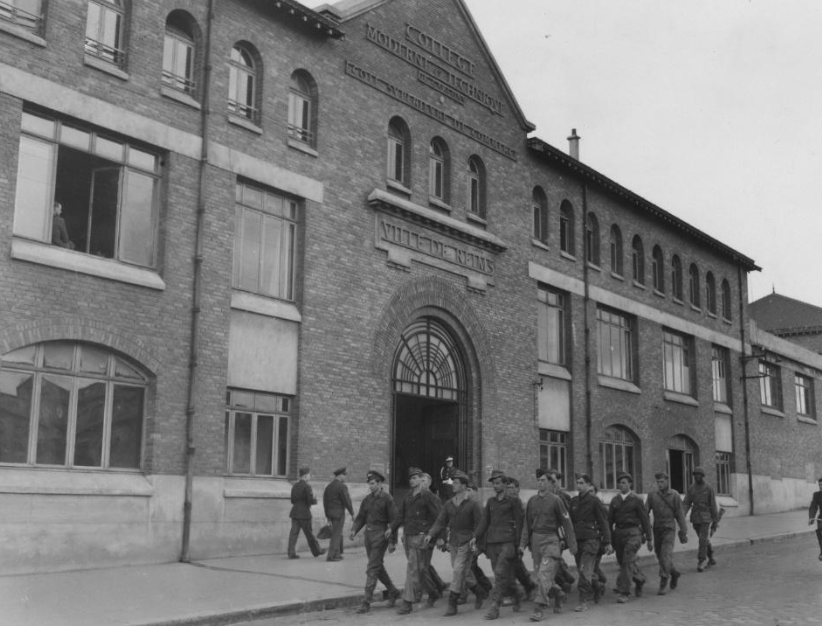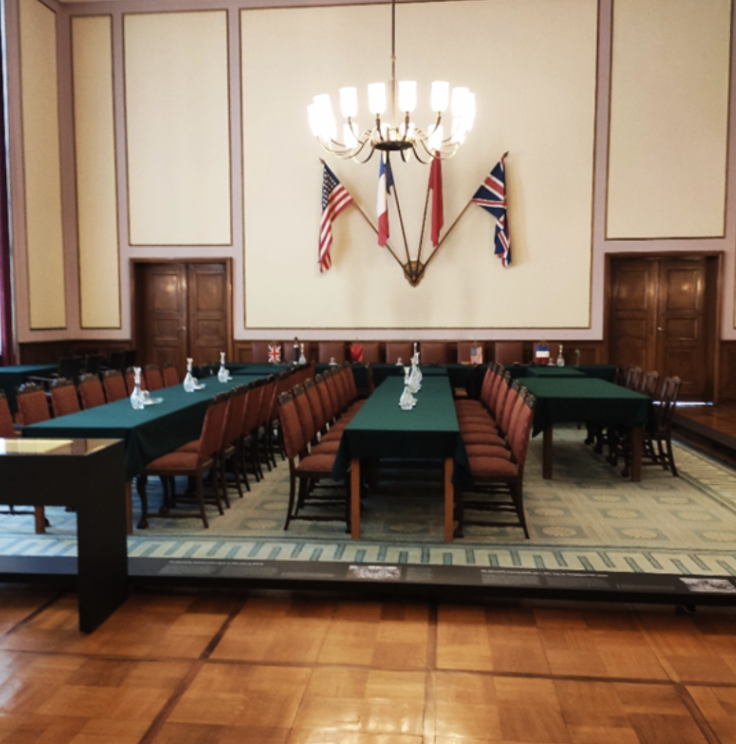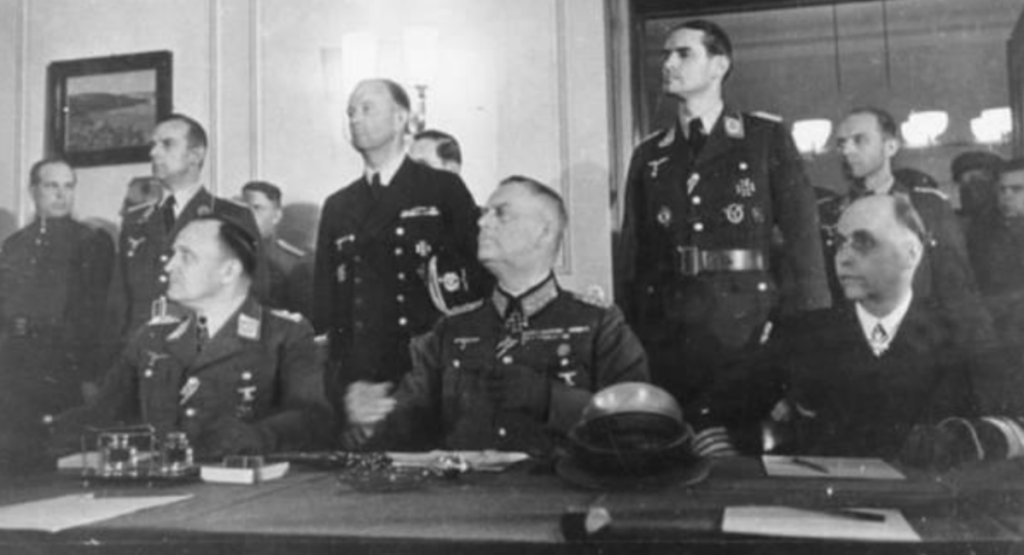From Reims to Karlshorst: On the Trail of History’s Greatest Military Capitulation
On May 7-8, 1945, Germany unconditionally surrendered its military forces to the Allies, marking the end of World War II in Europe. Read part one of the two-part series here.
As April slid into May on 1945, the mighty Wehrmacht disintegrated completely, irremediably. At that point, there was one thing that both the German armed forces and German civilians obsessed most about: how to flee the Red Army.
Unremitting Nazi hate propaganda over many years had convinced many ordinary Germans that the Soviet Union was a sinister cocktail of Slavic ‘depravity’, Jewish ‘greed’ and Communist ‘ungodliness’ and so a defeat at the Red Army’s hands would shove Germany back to the Dark Ages. As the Soviets tightened the noose on Berlin, therefore, military commanders scrambled to surrender to the Western Allies rather than to the Red Army, and an unending stream of German civilians flowed from the east to the west in the hope of finding shelter in areas held by the Western armies. Indeed, in April 1945 alone, more than 1.5 million German soldiers gave themselves up to the Western Allies, mainly the Americans (who found themselves hard-pressed to provide for such dramatically large numbers of prisoners). And that statistic doesn’t even cover the frenzied rush for surrender triggered by Hitler’s suicide on April 30.
Besides, top honchos of the Wehrmacht had their own reasons to avoid the Red Army like the plague: their own memories of their treatment of Soviet prisoners of war, Jews, partisans, communists, indeed, Soviet citizens in general in course of Operation Barbarossa. So they kept sending strong, repeated feelers to the Americans and the British that they wanted to conclude a separate peace with them. They suspected, not entirely unreasonably, that not everything was hunky-dory between the USSR and its Western Allies, and they sensed an opportunity here. Many of them clung desperately to the hope that the US and Britain would be happy to take the Nazis on board in their common struggle against Soviet ‘Bolshevism’.

German POWs near the Allied Headquarters, Reims. Photo: Public domain.
Karl Doenitz, the Hitler-anointed Nazi ‘Head of State’ who sat pretty at Flensburg up until May 23 when the British army picked him up and ended his ‘reign’, led these lunatics. It was at Doenitz’s instance that, while surrendering the German armies of northwestern Germany to Field Marshal Bernard Montgomery at Luenburg on May 4, Admiral von Friedeburg (who succeeded Doenitz as the head of the navy when the latter became ‘president’) broached the idea of a separate German peace with the Allies. He was rebuffed, but Doenitz was not about to give up. The next day, Doenitz sent Friedeburg to Eisenhower, Supreme Allied Commander in Europe, at Eisenhower’s headquarters at Reims, near Paris, with the same proposal. Eisenhower refused to budge – whereupon Doenitz asked Alfred Jodl, the Chief of Staff at the Wehrmacht and Friedeburg’s senior in rank, to proceed to Reims. Jodl’s brief? To pick up from where Friedeburg had left off and plead again with Eisenhower to permit Germany to surrender to the Western Allies on the western front, while keeping its options open on the east vis-à-vis the Soviets.
Reims, France, May 7, 1945
Thus it was that Alfred Jodl, Wehrmacht’s Chief of Staff, arrived at Reims in the evening of May 6 and renewed the offer, as from Karl Doenitz himself, to surrender all German forces fighting the Western Allies. A furious Eisenhower told him off, threatened to break off all negotiations, and warned Jodl that unless Germany agreed to a full unconditional surrender to all the Allies on all fronts at the same time, he would order all Western lines closed to surrendering German forces (thus obliging them to surrender to the Red Army) and resume bombing of all German-held positions. Jodl, scared, relayed the message back to Doenitz, who finally read the writing on the wall and authorised Jodl to do as Eisenhower told him. But it was well past midnight on May 6 or 7 that Jodl received the go-ahead from Doenitz.
The stage was now set for the signing of the surrender document, which took place around a black-topped conference table in the map-lined ‘War Room’ of the Allied headquarters at 02.41 am Central European time (CET) on May 7, 1945. Jodl signed for the Germans, while Gen. Bedell Smith, Eisenhower’s Chief of Staff and Soviet General Ivan Souslaparov signed on behalf of the Supreme Command, Allied Expeditionary Force and the Supreme High Command, Red Army, respectively. French Major-General Francois-Sevez signed as the official witness. The surrender was to take effect at 11.01 pm CET on May 8, thus allowing the Germans virtually a 48- hour ‘grace period’ in which to capitulate to the Allied front of their choice and move as many civilians as possible from the east to the west.

Jodl signs the capitulation
The two sides were required to sign multiple copies of the surrender instrument made out in English, German and Russian, but the signings per se took all of five or six minutes. After they were over, Jodl requested a few minutes’ time to ‘say a few words’. He then “spoke rapidly in German in a voice which seemed on the point of cracking once or twice”, as a United Press war correspondent reported. The unsteady voice was understandable, but the crass insensitivity, even arrogance, of what Jodl said was not lost on anyone present:
General, with this signature the German people and the German armed forces are for better or worse delivered into the victor’s hands.
In this war which has lasted more than five years both (i.e., German people and German army) have achieved more and suffered more perhaps than any other people in the world.
I express the hope the victor will treat them with generosity. (Emphasis added)
Germans achieving more and suffering more in the war than every other people : coming from a proud Nazi (who had signed decrees mandating the summary execution of captured Soviet soldiers and partisans), that was more than a little rich, surely. Not counting the fact that nearly everyone present there that night knew about the death camps by then.
Jodl was later taken to see Eisenhower (who had skipped signing out of protocol considerations) to whom he confirmed that he understood what he had signed off on. As he strode out, ‘pale-faced’, Jodl, a trifle comically, ‘tripped on a camera flashlight cable’, as the UP correspondent noted. After Jodl had left, a smiling, but restrained Eisenhower made a three-minute statement for newsreels declaring the defeat of Nazi Germany at Allied hands ‘on land, sea and in the air’.
General Souslaparov’s dilemma
At Eisenhower’s request, the Soviet High Command had seconded Souslaparov to Reims for participating in the surrender negotiations, but he had not been expressly authorised to sign on the Red Army’s behalf. After Jodl agreed to the surrender terms, Souslaparov forwarded the draft document to Moscow, requesting approval of the format and the authority to sign. It was way after midnight, however – Moscow is one hour ahead of CET – and no response had been received till the Reims signing. At that point, Souslaparov agreed to sign, but with the caveat that if his government had any additional comments on the signing, those would be accommodated by way of a suitable supplementary/ratificatory agreement. Eisenhower, who had a good working relationship with all the Allied country heads including Stalin, promptly agreed.
Stalin’s reservations
Stalin’s observations, received later on May 7, focused on the following:
- The final capitulation of Nazi Germany should in fairness happen only in Berlin – the capital city of Hitler’s Thousand-Year Reich – from where he had launched his murderous campaign for world conquest;
- Of all the Allied armies, the Red Army had inarguably paid the highest price in the war against Nazism. The process of German capitulation should acknowledge that sacrifice by having one of the Red Army’s senior-most commanders associated with the storming of Berlin take the surrender on behalf of the Soviet High Command (Souslaparov was a Major-General);
- Inadvertently, the Reims signing might have opened the door for a future ‘stab-in-the-back’ argument that so roiled German public opinion post World War I and facilitated Hitler’s rise. After all, Jodl represented Doenitz, Head of the German civilian administration, and he was nowhere near being the country’s topmost military leader. Unless the military top brass signed off on the capitulation, nothing might staunch future claims that the German military had been betrayed once again by civilian leaders. And inevitably, the Allies would be blamed for conniving in that betrayal.
Stalin went on to suggest that the Reims document be ratified by getting the heads of the German army, navy and air force to sign a second instrument of surrender in Berlin where one of the Red Army Marshals would officiate along with other Allied generals. If that follow-on document could be got executed before 11.01 pm CET on May 8, it would essentially supplement and enlarge the scope of the Reims signing, and not constitute a fresh surrender.

The signing room at Karlshorst today. Photo: Anjan Basu.
Other Allies agree with Stalin
The point about the ‘stab-in-the-back’ argument was unlikely to be lost on anyone familiar with the history of World War One. Eisenhower saw the point straightaway, as did Churchill, Trueman and De Gaulle when Eisenhower spoke with them. It was, of course, clear that one of Stalin’s motivations was to use the opportunity to showcase the Red Army’s magnificent victory in Berlin. But no one would have liked to look churlish and deny Stalin that request. It was a moment to savour one of history’s greatest military victories, and not cavil about details. The Cold War, at any rate, was not on the horizon just yet.
On to Karlshorst, Berlin
If it was Berlin, the master of ceremonies could hardly be anyone other than Marshal Georgy Zhukov. The Second World War had thrown up many brilliant Red Army commanders, but, by the war’s end, Zhukov stood taller than the others. He had fought at Moscow, at Stalingrad, Leningrad and Kursk, and was one of the heroes of Operation Bagration, a campaign that in many ways overshadowed even the fabled Operation Overlord. Finally, he had wrested Berlin from the Wehrmacht. Zhukov’s HQ in the Berlin suburb of Karlshorst was housed in what previously was a military engineering college – an interesting parallel to Eisenhower’s Reims HQ which operated out of a technical college campus. It was to this Karlshorst address that the signatories to the Berlin surrender were to repair on May 8, 1945.
The signatories on the German side were Field Marshal Wilhelm Keitel, Chief of the Wehrmacht’s High Command; Admiral von Friedeburg, Head of the Navy; and Colonel-General Hans Stumpff, Head of the Luftwaffe. The two principal signatories for the Allies were Air Chief Marshal Sir Arthur Tedder (standing in for Eisenhower, who skipped again for protocol reasons) and Marshal Zhukov., for the Red Army. General Carl Spaatz, Head of the (American) Strategic Air Forces, and General Lattre de Tassigny, representing the French Liberation Army, were to sign as witnesses.
Berlin-Karlshorst Museum
Karlshorst now houses the Berlin-Karlshorst museum, but locals still refer to it as the Russian museum, as I found out while I walked from where bus 296 had dropped me off. That is amusing, if you consider where that moniker comes from. Actually, after the war and during the GDR years, it had been christened the German-Russian Museum and dedicated to “German-Soviet relations and the German-Soviet war of 1941-45”. After Putin’s invasion of Ukraine in March 2022, however, any reference to the Russian connection was passe – hence the new name. As far as I could tell, however, the museum continues to be a bi-national institution with both Germans and Russians sitting on its board of trustees. But on the day I visited, the museum officials I met were all Russian.
The museum’s remit is the history of German-Soviet relations between 1917 and 1990, but its focus, unwaveringly, is on the war of 1941-45. It features an impressive permanent exhibition, but there’s no question that the heart of the museum throbs in the surrender room, which has been preserved in its original, 1945 shape. A video recording of the signing plays continuously on several TV monitors inside the surrender room, giving the visitor a ring-side view of one of the great events in history.
The final signing
Inevitably, there were a few glitches leading up to the signing. The room’s walls were to be decked with Allied flags, but no French flag being at hand, the Russians had to hand-craft one there and then. The first attempt, though, produced the Dutch flag, warranting a second shot which, thankfully, got the colours right. Next, several sentences were found missing from the Russian text : like at Reims, the document had three versions: Russian, German and English.

Stumpff, Keitel and Friedeburg (left to right) at Berlin signing
Once these elisions were addressed, Zhukov called the meeting to order and asked for the German delegation to enter. “Friedeburg and Stumpff looked resigned… (but) Keitel tried to look imperious, glancing almost contemptuously at Zhukov from time to time”. Keitel placed his marshal’s baton on the table in front, ostentatiously, clenched his fists and sat bolt straight in his chair. After Zhukov, then Tedder, then Spaatz and finally de Lattre signed, Zhukov stood up and invited the Germans to “sign the act of capitulation”. Keitel signalled that the papers be brought to him for signing. “Zhukov, however, pointed to the end of the table. ‘Tell them to come here to sign’, he told the interpreter.” Keitel, ‘his jowls hanging heavily like a bulldog’s’, stood up to comply. It was Zhukov’s day, after all.
Signings over, Zhukov asked the Germans to leave. As the door closed behind them, “it was almost as if everybody in the room exhaled in unison”. Everyone embraced one other in bear hugs. A night of celebrations awaited. A lttle later, gunfire was heard from all across the city as Red Armymen blasted their remaining ammunition into the night sky. The war was over. The time was somewhat after the 11.01 pm deadline, but no one seemed to mind. It was already May 9 in Moscow, and that was the cue for the Soviets to henceforth celebrate their victory a day after May 8, observed on the continent as the Victory-in-Europe Day.
Anjan Basu can be reached at basuanjan52@gmail.com. He posts on X @basuanjan52.
This article went live on May eighth, two thousand twenty five, at twenty-two minutes past nine in the morning.The Wire is now on WhatsApp. Follow our channel for sharp analysis and opinions on the latest developments.




